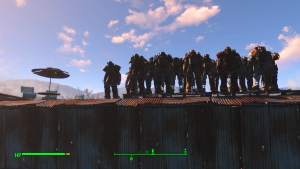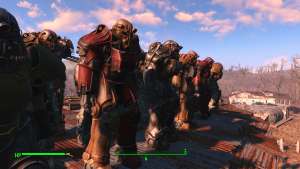 I really enjoyed Fallout 3 and Fallout: New Vegas. I played both of them to death, despite the bugs. It was therefore, no surprise to me that I was super excited about Fallout 4 when I heard it was being released. The only issue really, was Bethesda, they’re not well known for releasing bug free stuff, and on top of that, I’d found Skyrim to be lacking any soul. I feared that perhaps Fallout would be gutted, ripped of its sense of being and left cold and emotionless on the floor.
I really enjoyed Fallout 3 and Fallout: New Vegas. I played both of them to death, despite the bugs. It was therefore, no surprise to me that I was super excited about Fallout 4 when I heard it was being released. The only issue really, was Bethesda, they’re not well known for releasing bug free stuff, and on top of that, I’d found Skyrim to be lacking any soul. I feared that perhaps Fallout would be gutted, ripped of its sense of being and left cold and emotionless on the floor.
I needn’t have worried. I’ve read reviews and comments from people who find Fallout 4 lacking; they say it’s just a big tower defence game, or there’s little purpose beyond travel to point A, shoot the enemy to death, and then return to point B. I’d argue that’s no different to Fallout 3 certainly, although Fallout: New Vegas was a little richer than that. However, the key with all three games is that the main quest line, and in fact, most of the side quests, aren’t where Fallout games get their humanity, their soul, or their poignant introspective. They get those from the little letters, terminal messages, holotapes, non-main-quest NPC dialogue and other sources of background information. Seeking those out, reading everything is what gives me the sense of enjoyment from the world, and Fallout 4 delivers on that level as well as the others.

Power Armour Army – about half the suits I eventually collected. There they’re displayed on top of the three story house I built for myself.
There are tales spread throughout the whole of the Boston, Massachusetts (the location for Fallout 4) of people living, dying and being reborn in the aftermath of the nuclear war. Yes, there’s a main quest (mirroring that of Fallout 3 in many ways), and yes there are factions (bringing something from New Vegas more formally into Fallout 4). Yes, the Brotherhood of Steel turn up (of course), and there are raiders and supermutants and ghouls. There are vaults and mercenary groups, and bars and shops and blasted wasteland. All of these things are there. They’re all to be explored, and shot up. But the soul, the jam in the centre of this delicious doughnut is the treasure trove of hidden history that you only get by digging through the bodies of those you have vanquished.
Knee deep in ghoul remains, trying to find a vacuum tube, you discover a hastily scrawled note. A husband, telling his wife where he has gone, and that he will be back. You know he never made it. Half dead from a deathclaw attack, you open a cabin door and find the remains of a young woman, running away from home to be with her lost love. She never found him. Resplendent in your new power armour, you find an abandoned room in a sewer, and huddled in the corner is a skeleton, grasping the last Salisbury steak box a 10mm pistol and 5 rounds of ammo on the ground. You know they made a last stand, defending the boxed meat product from all-comers.
This is Fallout 4, this is why it still has a soul, and this is why I played it for over a hundred hours.
The main quest is clearly signposted as always, but you’ll struggle to simply follow that and do nothing else. As with Fallout 3 the second location you need to reach is a fair hike across the map and unless you have excellent luck and incredible tunnel vision, by the time you get there you’ll be knee deep in side quests. F4 has companions and factions which affect which quests you get offered, which ones you can complete and how the game ends. Having to repair weapons and armour has gone, and the crafting system from New Vegas has been boosted with weapons and armour being highly customisable. The two key new features are settlement building and the way power armour is handled. I won’t talk about how those features work (the web is covered in that) except to say, I really enjoyed the settlements, and while the new power armour has advantages and disadvantages, I enjoyed it, and found it less game breaking in some ways than the power armour in F3.
The all new voiced dialogue was interesting, and although I don’t think the game needed it I think it benefited from it. Dialogue wasn’t quite as witty as Fallout: New Vegas, but it was still engaging and at least on my first play-through of a quest (i.e. assuming I didn’t die and have to do it again) I didn’t skip any dialogue (which I’m notorious for, even when it’s unheard).
The locations are interesting, with some new approaches and some old classics. I did find some of the z-axis layouts very hard to understand and deal with – both inside buildings (their own discrete areas) and in the open world setting. There are some very high places you can reach through some very convoluted routes, which frustrated me several times. I’m sure other people love them, and I learned to deal with them, but as with F3 and F:NV, it’s not always obvious how to navigate around key locations.
NPC companions are varied and interesting, and their dialogue is all spectacularly different, which was enjoyable.
Some of the faction quests were very repetitive (especially the Minutemen), and they didn’t always feel joined up. I often completed a Minutemen quest for a settlement which had already joined the cause, only to be told it was great to get another settlement on-board. I didn’t personally suffer any significant bugs, certainly nothing quest related. I did get stuck in the scenery once and had to reload a save (Greté played on the PC, and the one time she got stuck she used a console command to get out, I was very jealous). There were times when my character just stood still after dialogue, both he and the NPC kind of playing chicken to see who would walk away first. It always resolved itself eventually but I’ve read some people getting stuck like that and having to reload.
Faction-breaking quests (where you cause one faction to hate you) are clearly telegraphed, and for the most part I knew if my actions were going to upset someone. However, as with F3 and F:NV it is possible to do the quests in such an order that you confuse the NPC’s who won’t let you hand a quest in because they’re eager to talk about something else. Also, as with all Bethesda games, I found NPC’s would assume I had knowledge of an event long before I actually triggered it.
Even with those flaws though, Fallout 4 was absorbing, engaging and fun. A worthy successor to Fallout 3 and although some might argue it doesn’t make enough of a step change, I always prefer evolution rather than revolution in my game sequels.
Play Fallout 4, it has a heart, and it wants to be your friend. If you’ve played Fallout 3, take time to look for all the connections that Fallout 4 has to that game. NPC’s, locations, events, and even the main storyline.
Note: The screenshots are from my Xbox One play through. It’s ridiculously complicated to get screenshots out of a game on the Xbox. In the end I had to sign up to One Drive, save them to that, and then get them on the PC via the One Drive web interface.




